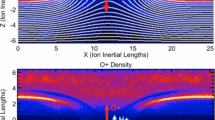Abstract
The dynamic global core plasma model (DGCPM) is used in this paper to calculate the He+ density distribution of the Earth’s plasmasphere and to investigate the configurations and 30.4 nm radiation properties of the plasmasphere. Validation comparisons between the simulation results and IMAGE mission observations show: That the equatorial structure of the plasmapause is mainly located near 5.5 R E and the typical scale of plasmasphere shrinking or expansion within 10 min is approximately 0.1 R E; that the plasmaspheric shoulders are formed and rotate noon-ward from the dawn sector under the conditions of strong southward turning of the interplanetary magnetic field (IMF); that the plasmaspheric plumes will rotate dawn-ward from the night sector and become narrow for the southward turning of the IMF. The simulated images from the lunar orbit show that the plasmasphere locating within the geocentric distance of 5.5 R E corresponds to field of view (FOV) of 10.7°×10.7° for the moon-based EUV imager, and that the 30.4 nm radiation intensity of the plasmasphere is 0.1–11.4 R. The plasmaspheric shoulders and plumes locating toward the moon-side are for the first time simulated with typical scale level of 0.1 R E from the side view of the moon. These simulated results provide an important theoretical basis for the lunar-based EUV camera design.
Similar content being viewed by others
References
Horwitz J L, Brace L H, Comfort R H, et al. Dual-spacecraft measurements of plasmasphere-ionosphere coupling. J Geophys Res, 1986, 91(A10): 11203–11216
Chiu Y T, Luhmann J G, Ching B K, et al. An equilibrium model of plasmasphere composition and density. J Geophys Res, 1979, 84(A3): 909–916
Farrugia C J, Geiss J, Young D T, et al. GEOS-1 observations of low-energy ions in the earth’s plasmasphere: a study on composition, and temperature and density structure under quiet geomagnetic conditions. Adv Space Res, 1988, 8(1): 25–33
Farrugia C J, Geiss J, Young D T, et al. The composition, and temperature and density structure of cold ions in the quiet terrestrial plasmasphere: GEOS-1 results. J Geophys Res, 1989, 94(A9): 11865–11891
Meier R R. Ultraviolet spectroscopy and remote sensing of the upper atmosphere. Space Sci Rev, 1991, 58: 1–185
Garrido D E, Smith R W, Swift D W, et al. Imaging the plasmasphere and trough region in the extreme ultraviolet region. Opt Eng, 1994, 33(2): 371–382
Garrido D E, Smith R W, Swift D W, et al. Imaging the Earth’s magnetosphere: Effects of plasma flow and temperature. Planet Space Sci, 39(11): 1559–1571
Brandt J C. Interplanetary gas, VI, On diffuse extreme ultraviolet helium radiation in the night and day sky. Astrophys J, 1961, 134: 975–980
Brandt J C, Chamberlain J W. Interplanetary gas, I, Hydrogen radiation in the night sky. Astrophys J, 1959, 130: 670–682
Ober D M, Horwitz J L, Gallagher D L. Formation of density troughs embedded in the outer plasmasphere by subauroral ion drift events. J Geophys Res, 1997, 102(A7): 595–602
Chen A J, Wolf R A. Effects on the plasmasphere of a time-varying convection electric field. Planet Space Sci, 1972, 20(4): 483–509
Rasmussen C E, Guitar S M, Thomas S G. A two dimensional model of the plasmasphere: Refilling time constant. Planet Space Sci, 1993, 41(1): 35–43
Tsyganenko N A, Sitnov M I. Modeling the dynamics of the inner magnetosphere during strong geomagnetic storms. J Geophys Res, 2005, 110(A03208), doi: 10.1029/2004JA010798
Weimer D R. Improved ionospheric electrodynamic models and application to calculating Joule heating rates. J Geophys Res, 2005, 110(A05306), doi: 10. 1029/2004JA010884
Carpenter D L, Anderson R R. An ISEE-Whistler model of equatorial electron density in the magnetosphere. J Geophys Res, 1992, 97(A2): 1097–1108
Ogawa T, Tohmatsu T. Sounding rocket observation of helium 304- and 584-Å glow. J Geophys Res, 1971, 76(25): 6136–6145
Roelof E C, Mauk B H, Meier R R. Instrument requirements for imaging the magnetosphere in extreme ultraviolet and energetic neutral atoms derived from computer-simulated images. Proc SPIE, 1992, 1744(1): 19–30
Nakamura M, Yoshikawa I, Yamazaki A, et al. Terrestrial plasmaspheric imaging by an extreme ultraviolet scanner on Planet-B. Geophys Res Lett, 2000, 27(2): 141–144
Matsui H, Mukai T, Ohtani S, et al. Cold dense plasma in the outer magnetosphere. J Geophys Res, 1999, 104(A11): 25077–25095
Murakami G, Hirai M, Yoshikawa I. The plasmapause response to the southward turning of the IMF derived from sequential EUV images. J Geophys Res, 2007, 112(A06217), doi: 10. 1029/2006JA012174
Goldstein J, Sandel B R, Forrester W T, et al. IMF-driven plasmasphere erosion of 10 July 2000. Geophys Res Lett, 2003, 30(3): 1146, doi: 10.1029/2002GL016478
Author information
Authors and Affiliations
Corresponding author
Additional information
This work was supported by the National Natural Science Foundation of China (Grants No. 40774098, 40774079 and 40890160), the National Hi-Tech Research and Development Program of China (“863” Project) (Grant No. 2007AA12Z314), and the Chinese Academy of Sciences Innovation Program.
Rights and permissions
About this article
Cite this article
He, F., Zhang, X., Chen, B. et al. Calculation of the extreme ultraviolet radiation of the earth’s plasmasphere. Sci. China Ser. E-Technol. Sci. 53, 200–205 (2010). https://doi.org/10.1007/s11431-009-0311-1
Received:
Accepted:
Published:
Issue Date:
DOI: https://doi.org/10.1007/s11431-009-0311-1




